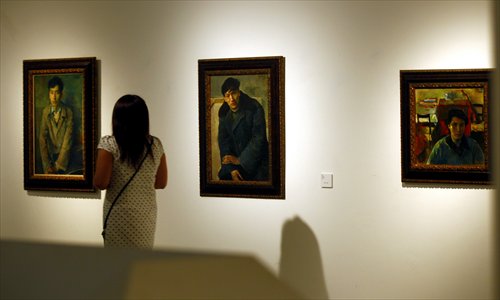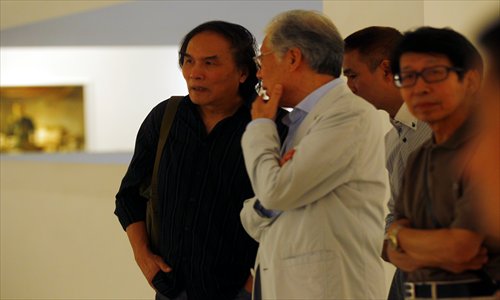Gentle gray
Two exhibitions currently being held at the Shanghai Oil Painting & Sculpture Institute in Changning district witnessed the reunion of two names, Chen Yifei and Xia Baoyuan. They were school fellows at the Shanghai Art College half a century ago and they composed giant oil paintings of Yellow River Cantata in the same room, back-to-back, in the early 1970s.
While Chen secured a reputation as one of the most important and commercially successful painters in China after his death in 2005, Xia, now 69, remains a private legend of the art world.

One of Xia Baoyuan's oil paintings on display at the ongoing exhibition at Shanghai Oil Painting & Sculpture Institute
Years of red and black
Dubbed one of the "Three Talents of Shanghai Fine Arts College" (the other two being Chen and Wei Jingshan), Xia was not assigned the profession of painter, however, but worked as a designer of cotton prints at the Shanghai Institute of Arts and Crafts after he graduated in 1965. This saved him from being sent down to the countryside as an educated youth when the Cultural Revolution (1966-1976) broke out, since he was considered a worker, not an artist.
It also freed Xia from the mission to paint "prestigious portraits" of Chairman Mao, which were needed everywhere at the time. Painters, including the self-appointed ones, would climb up scaffolding and, crouching, paint a part of Mao's face in exchange for better meals, soda water and huge amounts of paint.
"But real painters with ambitions quickly got tired of this business. They looked for chances to climb off the scaffolding," Xia recalled. "It was like monkeys climbing off the trees, an evolution."
In 1968, Jiefang Daily summoned all the talented painters back to Shanghai, Chen Yifei among them, to paint posters for the eight model plays. "If you look at the building of Jiefang Daily, you see the shape of an umbrella. It was literally an umbrella for us," Xia said.
The real turn for Chen and Xia came in 1971, when they were called, at the suggestion of an editor at Jiefang Daily named Hong Guangwen, to paint a set of four giant oil paintings depicting Xian Xinghai's 1939 patriotic composition Yellow River Cantata along with other painters. Chen and Xia were in the same group and worked in the same room. They were assigned the middle two paintings of the series, Ode to the Yellow River and Fury of the Yellow River.
They were sent to nearby provinces to "experience life" and "to be educated" before painting. The first versions of the two paintings were destroyed. Again the painters were sent "to be educated" and they painted second versions in 1972. Xia's Fury of the Yellow River finally consisted of a group of soldiers, who were accused of "looking gloomy" and "in terror of war" by the authorities. The painting was confiscated and never exhibited to the public.
"They just wanted soldiers to look clean and rosy-cheeked, like in model plays," Xia said. "Sometimes it was not just politics but also the jealousy of your peers. Only the professionals could make professional slanders."
Xia's works were chosen to be included in the humiliating Exhibition of Black Paintings in April 1974 because his paintings were not "politically correct."

A visitor looks at the oil paintings by artist Xia Baoyuan. Photos: Yang Hui/GT
Underground master
Officially banned, Xia could not make "black paintings" anymore. But he developed a hobby that would later mark his name nationwide: sketches. In distaste for the rosy-cheeked heroes of model plays, Xia turned his attention to ordinary people.
"I had no other choice," Xia said.
"Sensitive, nimble, succinct and graceful, the sketches were of exceptional quality," Chen Danqing, a renowned painter himself and Xia's junior school fellow, recalled in an article. "One day when we were riding on the road, discussing whose sketches were the best, Chen Yifei suddenly said that in fact we were all in debt to Xia Baoyuan."
Through the years, Chen Danqing was surprised to find photocopies of Xia's sketch works, fuzzy from being reprinted too many times, scattered around the country, even as far as Xinjiang and Tibet. Xia himself was surprised when he first heard about it.
"There were people selling photocopies of my sketches, 5 ($0.82) or 10 yuan each, to art students. But actually some were not even my work, they just put my name on it," Xia said.
The other achievement that Xia attributed to having no other choice was to introduce Western oil painting techniques to Chinese water brush paintings. In the late 1970s, when few exhibitions were held, the only way for painters to find an audience was to get published in the form of comics that educated children with stories of celebrated historical figures, such as writer Lu Xun (1881-1936) or painter Xu Beihong (1895-1953).
"I had too many pictures to draw so I managed to draw with brushes," Xia said. But the effect of these miniature paintings was excellent. Old people and old places were depicted in an elegant old-fashioned style. From 1965 to 1976, Xia produced 10 series of ink wash comics, 40 pictures from which are on display at the exhibition which ends on Thursday.

Xia Baoyuan (left) talks to visitors to his exhibition.
There and back again
Things turned better for Xia after the Cultural Revolution. His talent for oil painting was rediscovered and recognized. His portraits, unlike Chen Yifei's grandiose depictions of historic moments, captured the gray poetry of humble lives in Shanghai. He was appointed director of oil painting at the Shanghai Oil Painting & Sculpture Institute in 1985 and named a First Level Artist of the Nation in 1988.
That same year, he flew to the US, where he stayed for 16 years.
Once again he worked as a designer instead of a painter because he didn't want to compromise his art by catering to the commercial tastes of American galleries. "People would bring a piece of their wallpaper to a gallery to see if a painting goes well with it," Xia said.
In 2005, he returned to Shanghai as a special professor of the newly founded Shanghai Institute of Visual Art. And the government still assigns him work of giant oil paintings.
"I came back because I felt I should," he said simply and peacefully, looking not too different from the way he does in his 1988 masterpiece Minister and I, which depicts a younger Xia Baoyuan staring peacefully at a giant blank canvas that is bigger than the minister himself.